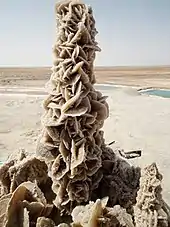Desert rose (crystal)
Desert rose is the colloquial name given to rose-like formations of crystal clusters of gypsum or baryte which include abundant sand grains.[1] The 'petals' are crystals flattened on the c crystallographic axis, fanning open in radiating flattened crystal clusters.



The rosette crystal habit tends to occur when the crystals form in arid sandy conditions,[1] such as the evaporation of a shallow salt basin. The crystals form a circular array of flat plates, giving the rock a shape similar to a rose blossom. Gypsum roses usually have better defined, sharper edges than baryte roses. Celestine and other bladed evaporite minerals may also form rosette clusters.[1] They can appear either as a single rose-like bloom or as clusters of blooms, with most sizes ranging from pea sized to 4 inches (10 cm) in diameter.
The ambient sand that is incorporated into the crystal structure, or otherwise encrusts the crystals, varies with the local environment. If iron oxides are present, the rosettes take on a rusty tone.
The desert rose may also be known by the names: sand rose, Sahara rose, rose rock, selenite rose, gypsum rose and baryte (barite) rose.
Locations
Rose rocks are found in Cyprus, Tunisia, Libya, Morocco, Algeria, Jordan, Saudi Arabia, Qatar, Egypt, the United Arab Emirates, Spain (Fuerteventura, Canary Islands; Canet de Mar, Catalonia; La Almarcha, Cuenca), Mongolia (Gobi), Germany (Rockenberg), the United States (central Oklahoma; Cochise County, Arizona; Texas), Mexico (Ciudad Juárez, Chihuahua), Australia, South Africa and Namibia.
Tunisian and Algerian sandroses
Sand roses are found in large numbers in the Sahara desert of Tunisia and neighboring Algeria. They are located in the surroundings of the Salt Lake of Chott el Djerid in South-West Tunisia. Local inhabitants extract them and sell them as souvenirs to tourists, creating a sustainable income to local population. Other sandroses are found elsewhere in the Sahara, but those extracted in the surroundings of the Salt Lake are particularly beautiful because of the high percentage of salt in their composition making them more crystalline and luminous. Others that contain more sand have a rusty tone, hence less brilliant in day or artificial light.
Formations in Oklahoma
Rose rock in Oklahoma was formed during the Permian Period, 250 million years ago, when western and central Oklahoma was covered by a shallow sea. As the sea retreated, baryte precipitated out of the water and crystallized around grains of quartz sand. This left behind large formation of reddish sandstone, locally called Garber Sandstone, containing deposits of rose rock.[2]
The rose rock was selected as the official rock of the US state of Oklahoma in 1968.[2]
Size
The average size of rose rocks are anywhere from 0.5 inches (1.3 cm) to 4 inches (10 cm) in diameter. The largest recorded by the Oklahoma Geological Survey was 17 inches (43 cm) across and 10 inches (25 cm) high, weighing 125 pounds (57 kg). Clusters of rose rocks up to 39 inches (99 cm) tall and weighing more than 1,000 pounds (454 kg) have been found.[3]
References
- Desert rose on Mindat.org
- "ROSE ROCK". Oklahoma Historical Society.
- "Noble is the Rose Rock Capital of the World". Oklahoma Tourism & Recreation Department.
External links
| Wikimedia Commons has media related to Desert rose. |